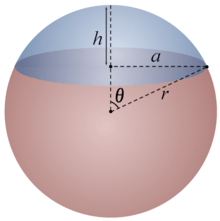Spherical cap

In geometry, a spherical cap, spherical dome, or spherical segment of one base is a portion of a sphere cut off by a plane. If the plane passes through the center of the sphere, so that the height of the cap is equal to the radius of the sphere, the spherical cap is called a hemisphere.
Volume and surface area
If the radius of the base of the cap is , and the height of the cap is , then the volume of the spherical cap is[1]
and the curved surface area of the spherical cap is[1]
or
The relationship between and is irrelevant as long as . The red section of the illustration is also a spherical cap.
The parameters , and are not independent:
Substituting this into the area formula gives:
- .
Note also that in the upper hemisphere of the diagram, , and in the lower hemisphere ; hence in either hemisphere and so an alternative expression for the volume is
- .
The volume may also be found by integrating under a surface of rotation, using and factorizing.
- .
Applications
Volumes of union and intersection of two intersecting spheres
The volume of the union of two intersecting spheres of radii r1 and r2 is [2]
- ,
where
is the sum of the volumes of the two isolated spheres, and
the sum of the volumes of the two spherical caps forming their intersection. If d < r1 + r2 is the distance between the two sphere centers, elimination of the variables h1 and h2 leads to[3][4]
- .
Surface area bounded by circles of latitude
The surface area bounded by two circles of latitude is the difference of surface areas of their respective spherical caps. For a sphere of radius r, and latitudes φ1 and φ2, the area is [5]
For example, assuming the Earth is a sphere of radius 6371 km, the surface area of the arctic (north of the Arctic Circle, at latitude 66.56° as of August 2016[6]) is 2π·6371²|sin 90° − sin 66.56°| = 21.04 million km², or 0.5·|sin 90° − sin 66.56°| = 4.125% of the total surface area of the Earth.
Generalizations
Sections of other solids
The spheroidal dome is obtained by sectioning off a portion of a spheroid so that the resulting dome is circularly symmetric (having an axis of rotation), and likewise the ellipsoidal dome is derived from the ellipsoid.
Hyperspherical cap
Generally, the -dimensional volume of a hyperspherical cap of height and radius in -dimensional Euclidean space is given by [7]
where (the gamma function) is given by .
The formula for can be expressed in terms of the volume of the unit n-ball and the hypergeometric function or the regularized incomplete beta function as
- ,
and the area formula can be expressed in terms of the area of the unit n-ball as
- ,
where .
Earlier in [8] (1986, USSR Academ. Press) the following formulas were derived: , where ,
.
For odd
.
It is shown in [9] that, if and , then where is the integral of the standard normal distribution.
See also
- Circular segment — the analogous 2D object
- Solid angle — contains formula for n-sphere caps
- Spherical segment
- Spherical sector
- Spherical wedge
References
- 1 2 Polyanin, Andrei D; Manzhirov, Alexander V. (2006), Handbook of Mathematics for Engineers and Scientists, CRC Press, p. 69, ISBN 9781584885023.
- ↑ Connolly, Michael L. (1985). "Computation of molecular volume". J. Am. Chem. Soc. 107: 1118–1124. doi:10.1021/ja00291a006.
- ↑ Pavani, R.; Ranghino, G. (1982). "A method to compute the volume of a molecule". Comput. Chem. 6: 133–135. doi:10.1016/0097-8485(82)80006-5.
- ↑ Bondi, A. (1964). "Van der Waals volumes and radii". J. Phys. Chem. 68: 441–451. doi:10.1021/j100785a001.
- ↑ Scott E. Donaldson, Stanley G. Siegel. "Successful Software Development". Retrieved 29 August 2016.
- ↑ "Obliquity of the Ecliptic (Eps Mean)". Neoprogrammics.com. Retrieved 2014-05-13.
- ↑ Li, S (2011). "Concise Formulas for the Area and Volume of a Hyperspherical Cap". Asian J. Math. Stat. 4 (1): 66–70. doi:10.3923/ajms.2011.66.70.
- ↑ Chudnov, Alexander M. (1986). "On minimax signal generation and reception algorithms (rus.)". Problems of Information Transmission. 22 (4): 49–54.
- ↑ Chudnov, Alexander M (1991). "Game-theoretical problems of synthesis of signal generation and reception algorithms (rus.)". Problems of Information Transmission. 27 (3): 57–65.
Additional reading
- Richmond, Timothy J. (1984). "Solvent accessible surface area and excluded volume in proteins: Analytical equation for overlapping spheres and implications for the hydrophobic effect". J. Mol. Biol. 178 (1): 63–89. doi:10.1016/0022-2836(84)90231-6.
- Lustig, Rolf (1986). "Geometry of four hard fused spheres in an arbitrary spatial configuration". Mol. Phys. 59 (2): 195–207. Bibcode:1986MolPh..59..195L. doi:10.1080/00268978600102011.
- Gibson, K. D.; Scheraga, Harold A. (1987). "Volume of the intersection of three spheres of unequal size: a simplified formula". J. Phys. Chem. 91 (15): 4121–4122. doi:10.1021/j100299a035.
- Gibson, K. D.; Scheraga, Harold A. (1987). "Exact calculation of the volume and surface area of fused hard-sphere molecules with unequal atomic radii". Mol. Phys. 62 (5): 1247–1265. Bibcode:1987MolPh..62.1247G. doi:10.1080/00268978700102951.
- Petitjean, Michel (1994). "On the analytical calculation of van der Waals surfaces and volumes: some numerical aspects". Int. J. Quant. Chem. 15 (5): 507–523. doi:10.1002/jcc.540150504.
- Grant, J. A.; Pickup, B. T. (1995). "A Gaussian description of molecular shape". J. Phys. Chem. 99 (11): 3503–3510. doi:10.1021/j100011a016.
- Busa, Jan; Dzurina, Jozef; Hayryan, Edik; Hayryan, Shura (2005). "ARVO: A fortran package for computing the solvent accessible surface area and the excluded volume of overlapping spheres via analytic equations". Comp. Phys. Commun. 165: 59–96. Bibcode:2005CoPhC.165...59B. doi:10.1016/j.cpc.2004.08.002.
External links
| Wikimedia Commons has media related to Spherical caps. |
Derivation and some additional formulas.